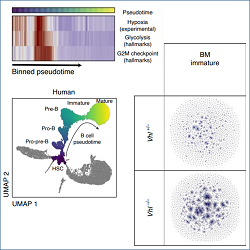
Hypoxia-inducible factor (HIF) 1α is a key orchestrator of a wide range of responses to changes in cellular oxygen levels. Dr Natalie Burrows and colleagues from Prof. Patrick Maxwell’s lab at CIMR, together with other co-authors, have reported in Nature Immunology an essential role for HIF1α in the early development of B cells. Deep inside bone marrow, elevated HIF1α activity acts a developmental brake within immature B cells- which is released upon their transition to a less hypoxic state, enabling their subsequent departure from the bone marrow and development. This involves a key tolerance mechanism, a process that limits the survival of B cells that recognise self. Additional experiments in mice using a pharmacological activator of the HIF pathway support this link further, opening up potential therapeutic applications in certain autoimmune conditions or B cell malignancies.

